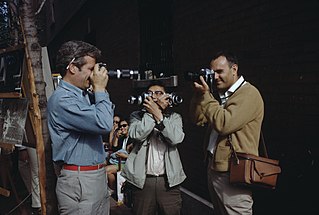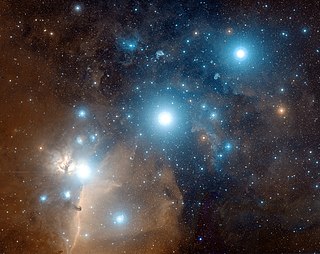Related Research Articles

Photography is the art, application, and practice of creating images by recording light, either electronically by means of an image sensor, or chemically by means of a light-sensitive material such as photographic film. It is employed in many fields of science, manufacturing, and business, as well as its more direct uses for art, film and video production, recreational purposes, hobby, and mass communication.

A photographer is a person who makes photographs.

Astrophotography, also known as astronomical imaging, is the photography or imaging of astronomical objects, celestial events, or areas of the night sky. The first photograph of an astronomical object was taken in 1840, but it was not until the late 19th century that advances in technology allowed for detailed stellar photography. Besides being able to record the details of extended objects such as the Moon, Sun, and planets, modern astrophotography has the ability to image objects outside of the visible spectrum of the human eye such as dim stars, nebulae, and galaxies. This is accomplished through long time exposure as both film and digital cameras can accumulate and sum photons over long periods of time or using specialized optical filters which limit the photons to a certain wavelength.
Digital imaging or digital image acquisition is the creation of a digital representation of the visual characteristics of an object, such as a physical scene or the interior structure of an object. The term is often assumed to imply or include the processing, compression, storage, printing and display of such images. A key advantage of a digital image, versus an analog image such as a film photograph, is the ability to digitally propagate copies of the original subject indefinitely without any loss of image quality.

Photojournalism is journalism that uses images to tell a news story. It usually only refers to still images, but can also refer to video used in broadcast journalism. Photojournalism is distinguished from other close branches of photography by having a rigid ethical framework which demands an honest but impartial approach that tells a story in strictly journalistic terms. Photojournalists contribute to the news media, and help communities connect with one other. They must be well-informed and knowledgeable, and are able to deliver news in a creative manner that is both informative and entertaining.

A camera phone is a mobile phone which is able to capture photographs and often record video using one or more built-in digital cameras. It can also send the resulting image wirelessly and conveniently. The first commercial phone with color camera was the Kyocera Visual Phone VP-210, released in Japan in May 1999.

Flickr is an image hosting and video hosting service, as well as an online community, founded in Canada and headquartered in the United States. It was created by Ludicorp in 2004 and was previously a common way for amateur and professional photographers to host high-resolution photos. It has changed ownership several times and has been owned by SmugMug since April 20, 2018.

A geotagged photograph is a photograph which is associated with a geographic position by geotagging. Usually this is done by assigning at least a latitude and longitude to the image, and optionally elevation, compass bearing and other fields may also be included.
Image sharing, or photo sharing, is the publishing or transfer of digital photos online. Image sharing websites offer services such as uploading, hosting, managing and sharing of photos. This function is provided through both websites and applications that facilitate the upload and display of images. The term can also be loosely applied to the use of online photo galleries that are set up and managed by individual users, including photoblogs. Sharing means that other users can view but not necessarily download images, and users can select different copyright options for their images.

Candid photography is photography captured without creating a posed appearance. This style is also called street photography, spontaneous photography or snap shooting. Professional photographers sometimes shoot candid photos of strangers on the street or in other public places such as parks and beaches. Candid photography captures natural expressions and moments that might not be possible to reproduce in a studio or posed photo shoot. This style of photography is most often used to capture people in their natural state without them noticing the camera. The main focus is on capturing the candid expressions and moments of life. Candid photography can be used in a variety of settings such as family gatherings, special events, and everyday street scenes. It is also a popular choice for wedding photos and professional portraits. Candid photography is often seen as a more honest representation of the subject than posed photography. To capture candid photos, the photographer may need to observe the subject from a distance or use a long lens or telephoto zoom lens. This allows for capturing the subject in their natural environment without them being aware of the camera. The photographer may need to be quick and have an eye for interesting compositions and backgrounds.

Geotagging, or GeoTagging, is the process of adding geographical identification metadata to various media such as a geotagged photograph or video, websites, SMS messages, QR Codes or RSS feeds and is a form of geospatial metadata. This data usually consists of latitude and longitude coordinates, though they can also include altitude, bearing, distance, accuracy data, and place names, and perhaps a time stamp.
A virtual tour is a simulation of an existing location, usually composed of a sequence of videos, still images or 360-degree images. It may also use other multimedia elements such as sound effects, music, narration, text and floor map. It is distinguished from the use of live television to affect tele-tourism.

Digital photography uses cameras containing arrays of electronic photodetectors interfaced to an analog-to-digital converter (ADC) to produce images focused by a lens, as opposed to an exposure on photographic film. The digitized image is stored as a computer file ready for further digital processing, viewing, electronic publishing, or digital printing. It is a form of digital imaging based on gathering visible light.

Sports photography refers to the genre of photography that covers all types of sports.
Real-time geotagging refers to the automatic technique of acquiring media, associating a specific location with the media, transferring the media to an online map and publishing the media in real time. It is thus an extension of an automatic geotagging process, requiring an in-built or attached location acquisition device, but also requires communication with a wireless data transfer device. Most modern smartphones and several digital cameras already integrate camera, aGPS, and wireless data transfer into one device, thus directly producing a geotagged photograph. Real-time geotagging is sometimes referred to as "mobile geotagging" or "autogeotagging", but this does not imply the real-time publishing step.
Fotki is a digital photo sharing, video sharing and media social network website and web service suite; it is one of the world's largest social networking sites. As an image hosting service, Fotki licenses photo-sharing software for global companies such as Telecom Italia, Alice.it, Sears, Mark Travel, Vegas.com, and Funjet.com, among others.
Amateur pornography is a category of pornography that features models, actors or non-professionals performing without pay, or actors for whom this material is not their only paid modeling work. Reality pornography is professionally made pornography that seeks to emulate the style of amateur pornography. Amateur pornography has been called one of the most profitable and long-lasting genres of pornography.

A star trail is a type of photograph that uses long exposure times to capture diurnal circles, the apparent motion of stars in the night sky due to Earth's rotation. A star-trail photograph shows individual stars as streaks across the image, with longer exposures yielding longer arcs. The term is used for similar photos captured elsewhere, such as on board the International Space Station and on Mars.

A selfie is a self-portrait photograph or a short video, typically taken with an electronic camera or smartphone. The camera would be usually held at arm's length or supported by a selfie stick instead of being controlled with a self-timer or remote. The concept of shooting oneself while viewing their own image in the camera's LCD monitor is also known as self-recording.

Photography in Sudan refers to both historical as well as to contemporary photographs taken in the cultural history of today's Republic of the Sudan. This includes the former territory of present-day South Sudan, as well as what was once Anglo-Egyptian Sudan, and some of the oldest photographs from the 1860s, taken during the Turkish-Egyptian rule (Turkiyya). As in other countries, the growing importance of photography for mass media like newspapers, as well as for amateur photographers has led to a wider photographic documentation and use of photographs in Sudan during the 20th century and beyond. In the 21st century, photography in Sudan has undergone important changes, mainly due to digital photography and distribution through social media and the Internet.
References
- ↑ Writing Project - Social Photography, January 21, 2008, last accessed May 8, 2008
- ↑ "The Flashpacker: A New Breed of Traveler". Hotel Travel News. March 24, 2006.
- ↑ "Social Change Photography", FiftyCrows.org, last accessed May 8, 2008
- ↑ "Wireless Digital Camera Guide", PhotographyReview.com, last accessed May 9, 2008
- ↑ "The professionals, the media and the people", The Democratic Image Archived 2008-07-19 at the Wayback Machine , Hughes Leglise, April 21st, 2007, last accessed May 8, 2008